

|
Breast Plate Designs
|
|

Brian E.Fields made a booklet : "Breast Plate designs." Because I liked it and
because there was a great demand for fancy knots I aksed and got permission to publish a
part of this work on the WEB.
If you like it and want the complete booklet you can find detailed information on how to
buy it on The IGKT store
In the booklet you will find about 20 breast plates and about 5 mats. On this page you
find a sample of 5 breastplates from his booklet. 
These breastplates are small enough to be tied in the hand, but if you have ten thumbs, by
all means use a board and pins.
A nine feet, three meter, fathom and a half lenght of two mm line is sufficient to make
and double all these designs and form the neck loop. When tieng a knot start in the middle
of the line and work with one end and then the other. 
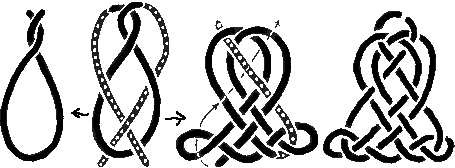 Start with a twist ..
and lock it in position aby using the ends (see diagram right). Extend the bottom loop in
the directions shown by the arrows.
Start with a twist ..
and lock it in position aby using the ends (see diagram right). Extend the bottom loop in
the directions shown by the arrows.
The extended bottom loop is twisted to produce a locked bight on either side and these
bights are held in position by passing the right side end as shown and then using the left
end to lock and finish the knot.
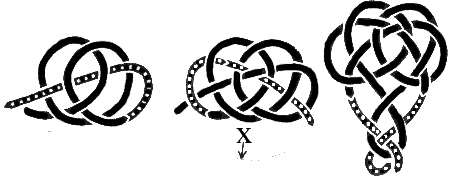 Start with two in terlinked half hitches and pass one end as shown.
Start with two in terlinked half hitches and pass one end as shown.
The second end may now be passed in a regular over and under weave to complete the
first part of the knot. Next work slack around the to extend bight x which is then twisted
to lock.
The working ends are then used to lock the twisted bight in position and the knot is
ready for doubling.
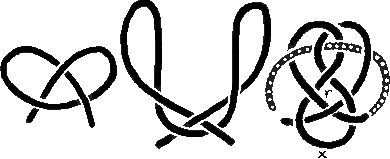 Start with a half
knot and lengthen the two bights. Twist the bights to lock them (this will produce a
regular over and under weave).
Start with a half
knot and lengthen the two bights. Twist the bights to lock them (this will produce a
regular over and under weave).
Lay one bight over the other (check that the sequence is correct by examining the
rectangle r) Take one end and lock the bights as shown. Arrange the doubling so that both
ends finish at x ~ this is the top loop of the knot.
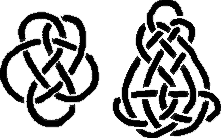 The finished design
is small but does form a basis for other patterns such as the design on the right. How to
develop one from the other is your problem! (Solved on the next page in the booklet.)
The finished design
is small but does form a basis for other patterns such as the design on the right. How to
develop one from the other is your problem! (Solved on the next page in the booklet.)
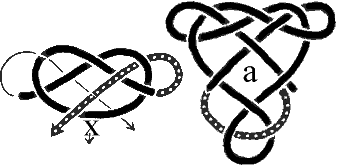 Start with two bights
(unlocked half knot) and lock by passing the ends as shown. Extend bight x.
Start with two bights
(unlocked half knot) and lock by passing the ends as shown. Extend bight x.
Twist the extended bight so as to lock it, (check the rectangle a. just to make sure the
twist was correct), and pass the end as shown to complete the knot. Double (or preferably
treble).
I believe this must have been the method used by the Viking who made the Bornhol
pendant (dated 800ac-100 ac). He worked with three strands of wire rather than face the
problems of trebling, and the work hardening that would inevitably affect the wire when
bent as often as required by the tripling technique.
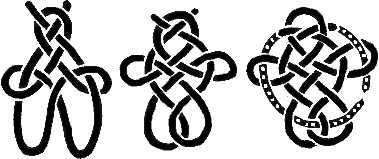 Start with Mors du
Cheval (see previous knot) and extend the two center bottom bights.
Start with Mors du
Cheval (see previous knot) and extend the two center bottom bights.
Twist these extended bights to lock them and place one over the other, as shown.
The working ends are then pased as shown n a regular over and under weave to lock and
complete the knot.
Its not quite a ´Tribulation´,but it was still a d--- n--- work out ~ hence the title.
![]()

Because this is an non-commercial site I can and will not allow junk mail nor spam. Therefore commercial, non personal and bulk mail will be charged with handling costs of $100 per mail.
